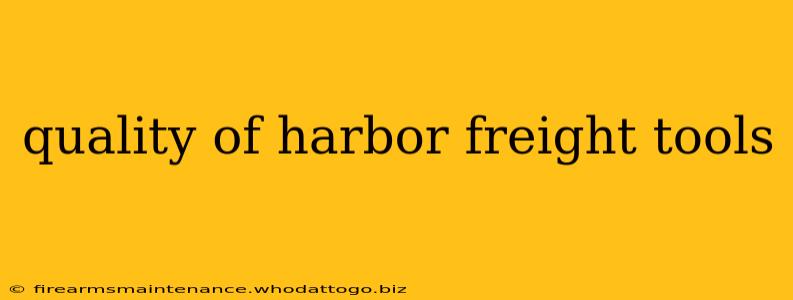Harbor Freight Tools has become a ubiquitous presence in the world of affordable tools. But are their tools any good? The short answer is: it depends. This in-depth analysis delves into the nuances of Harbor Freight's tool quality, helping you navigate the landscape and make informed purchasing decisions.
Understanding Harbor Freight's Business Model
Before diving into specific tool categories, it's crucial to understand Harbor Freight's business model. They operate on a high-volume, low-margin strategy. This means they sell a massive quantity of tools at significantly lower prices than competitors like Home Depot or Lowe's. This lower price point is achieved through strategic sourcing, often from overseas manufacturers, and a focus on efficient distribution. This model inherently impacts the quality of the tools offered.
The Spectrum of Harbor Freight Tool Quality
It's inaccurate to simply label all Harbor Freight tools as "bad." Their quality spans a broad spectrum:
The "Good Enough" Category:
Many Harbor Freight tools fall into this category. These are perfectly adequate for occasional DIY projects, light-duty tasks, or infrequent use. Examples might include:
- Basic Hand Tools: Screwdrivers, wrenches, pliers – often perfectly functional for home repairs and small projects. Expect shorter lifespans compared to professional-grade tools, but sufficient for occasional use.
- Certain Power Tools (with caveats): Some of their less demanding power tools, like certain drills or impact drivers (especially the newer models), can be surprisingly reliable for light to moderate use. Always check reviews before purchasing.
- Consumables: Items like drill bits, sanding discs, and cutting blades are often a good value, even if they don't last as long as premium brands.
The "Buyer Beware" Category:
This category includes tools that are generally not recommended for serious or professional use. These often show significant compromises in materials and construction:
- High-Stress Power Tools: Larger, more demanding power tools like saws, grinders, and compressors often suffer from durability issues and lack the safety features of higher-end brands. These are generally not recommended for anything beyond very light duty.
- Specialized Tools: Specialized tools, especially those involving precision or high-stress applications, are generally a gamble. It's best to invest in higher-quality tools in these areas.
- Early Model Tools: Harbor Freight is constantly updating its product line. Older model tools are more likely to suffer from quality control issues.
Factors Affecting Harbor Freight Tool Lifespan
Several factors influence the longevity of Harbor Freight tools:
- Intended Use: Using a tool beyond its capabilities will inevitably shorten its lifespan, regardless of brand.
- Maintenance: Proper care and maintenance can significantly extend the life of any tool, including those from Harbor Freight.
- Material Quality: Harbor Freight uses a variety of materials, and quality can vary greatly depending on the specific tool.
- Manufacturing Consistency: Like any mass-produced item, there will be variations in quality from tool to tool.
Making Informed Purchasing Decisions
To maximize your chances of getting a decent tool from Harbor Freight, follow these tips:
- Read Reviews: Thoroughly research the specific tool you're considering. Pay attention to both positive and negative reviews, looking for common themes and patterns.
- Check the Warranty: Harbor Freight offers warranties on many of its products. Understanding the warranty terms can help mitigate the risk of purchasing a faulty tool.
- Consider Your Needs: Be honest about the intensity and frequency of use. If you need a tool for heavy-duty professional use, Harbor Freight is likely not the best option.
- Don't Expect Miracles: Manage your expectations. Harbor Freight tools are designed for a price point, and this will often reflect in their durability and lifespan.
Conclusion: A Place for Harbor Freight Tools
Harbor Freight offers a convenient and affordable option for DIYers and those on a budget. However, it's essential to approach purchases strategically, understanding the limitations of their products. By carefully selecting tools, reading reviews, and managing expectations, you can successfully find functional tools at an attractive price point. But always remember: you often get what you pay for. For professional-grade performance and reliability, investing in higher-end brands is almost always advisable.

